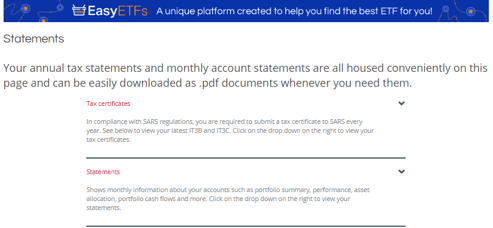As a taxpayer and EasyVestor, you will most definitely receive tax statements. Do you know why you receive these, and have you cracked the codes? Let us investigate what tax statements really are and how you can read them.
What are Tax statements?
These are statements that you receive annually on your accounts, the statements you receive monthly are called Investment statements. Your Easy account allows you to view and download all of your statements to provide you with a summary of how your investments are performing.
Understanding the codes on your statements
You need to understand what each of the codes on your statement mean for you to understand what your statement is telling you. So, let’s break it down:
IT3(a) – payments received from your Living Annuity
IT3(b) – interest and dividends received on your investment for this period
IT3(c) – capital gained for a period
IT3(f) – Contributions to your Retirement Annuity
IT3(s) – tax relating to your Tax - Free Savings account
Where do you find these statements on your Easy account?
When you log into your Easy account, head to the menu bar on the site, scroll right to the bottom of the page and select statements. This is where you can view and download your tax statements, as well as your certificates:

Understanding your statement:
- The dates indicated at the top of your statement refers to the tax year that your certificate is applicable to. The reason for the split in dates is that tax year runs from 1 March to the end February every year.
- The IT3(c) section of your statement: The code provides a summary of any capital gains (or losses from selling or disposing from your holdings. If you make a profit on your investment, this profit will need to be declared to SARS as a capital gain. The profit will be calculated using the price you bought the investment for versus what you sold it for. Remember you can have made a loss or a capital loss as well on your investment, which should also be given to SARS. Capital gains occur when you dispose of an asset (like a share) and the proceeds are higher than the original purchase price (the base cost).
- The IT3(b), refers to interest and dividends received both locally and offshore:
Local dividends - this would be local dividends you received during the tax year.
Foreign dividends – this would be offshore dividends you received during the tax year.
REIT taxable dividend – A REIT income is deemed to be a dividend and is taxed as such.
Interest – this is interest earned both locally and offshore.
Check out this cool blog on dividends I came across, that helped the young female investor I am, to understand dividends better and how they work: Dividends basics
You can also visit the SARS website to read more on capital gains, how to submit your returns and to get more in-depth information about your Taxes as an EasyVestor.
Read:
Tax education 101 - Tax Certificates
Any opinions, news, research, reports, analyses, prices, or other information contained within this research is provided by an employee of EasyEquities an authorised FSP (FSP no 22588) as general market commentary and does not constitute investment advice for the purposes of the Financial Advisory and Intermediary Services Act, 2002. First World Trader (Pty) Ltd t/a EasyEquities (“EasyEquities”) does not warrant the correctness, accuracy, timeliness, reliability or completeness of any information (i) contained within this research and (ii) received from third party data providers. You must rely solely upon your own judgment in all aspects of your investment and/or trading decisions and all investments and/or trades are made at your own risk. EasyEquities (including any of their employees) will not accept any liability for any direct or indirect loss or damage, including without limitation, any loss of profit, which may arise directly or indirectly from use of or reliance on the market commentary. The content contained within is subject to change at any time without notice.
